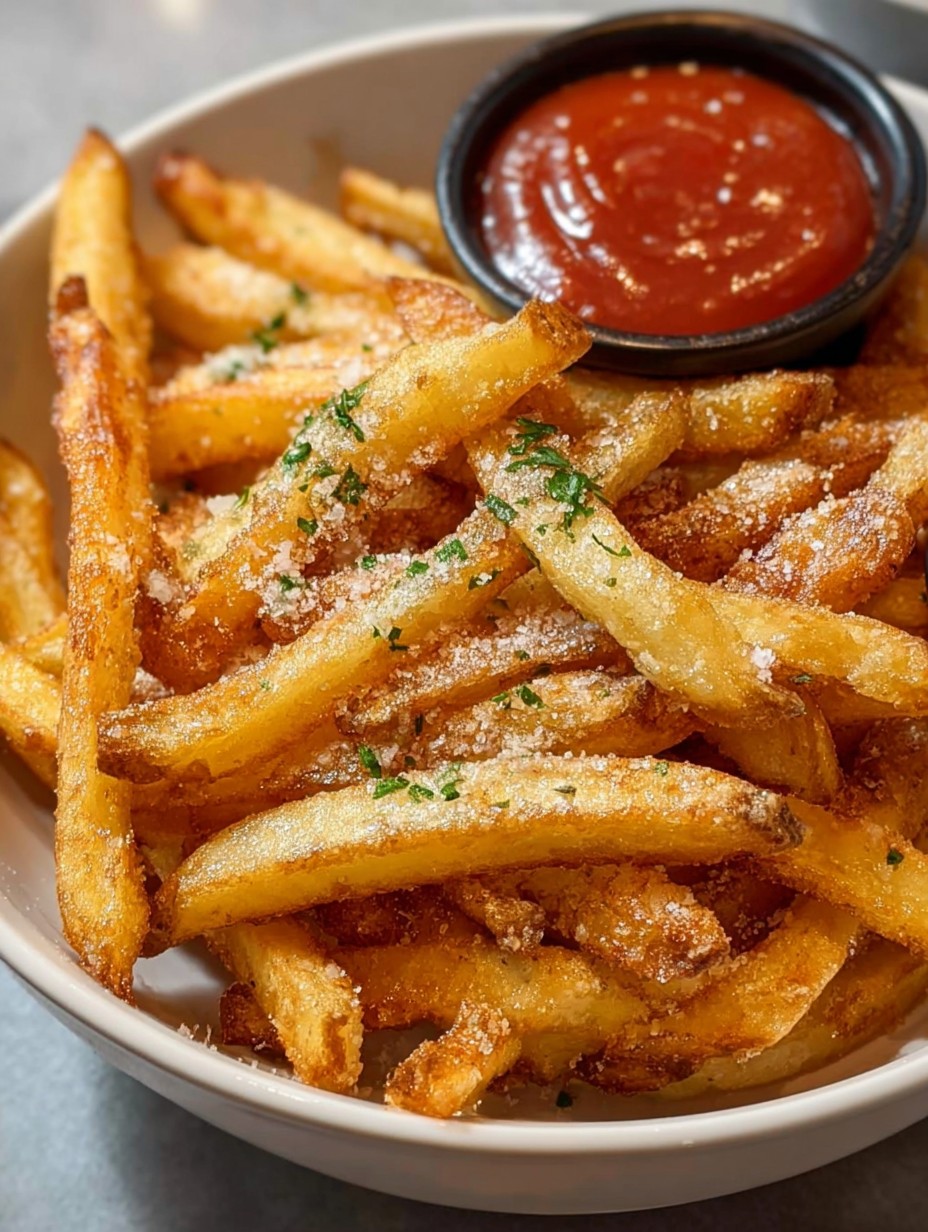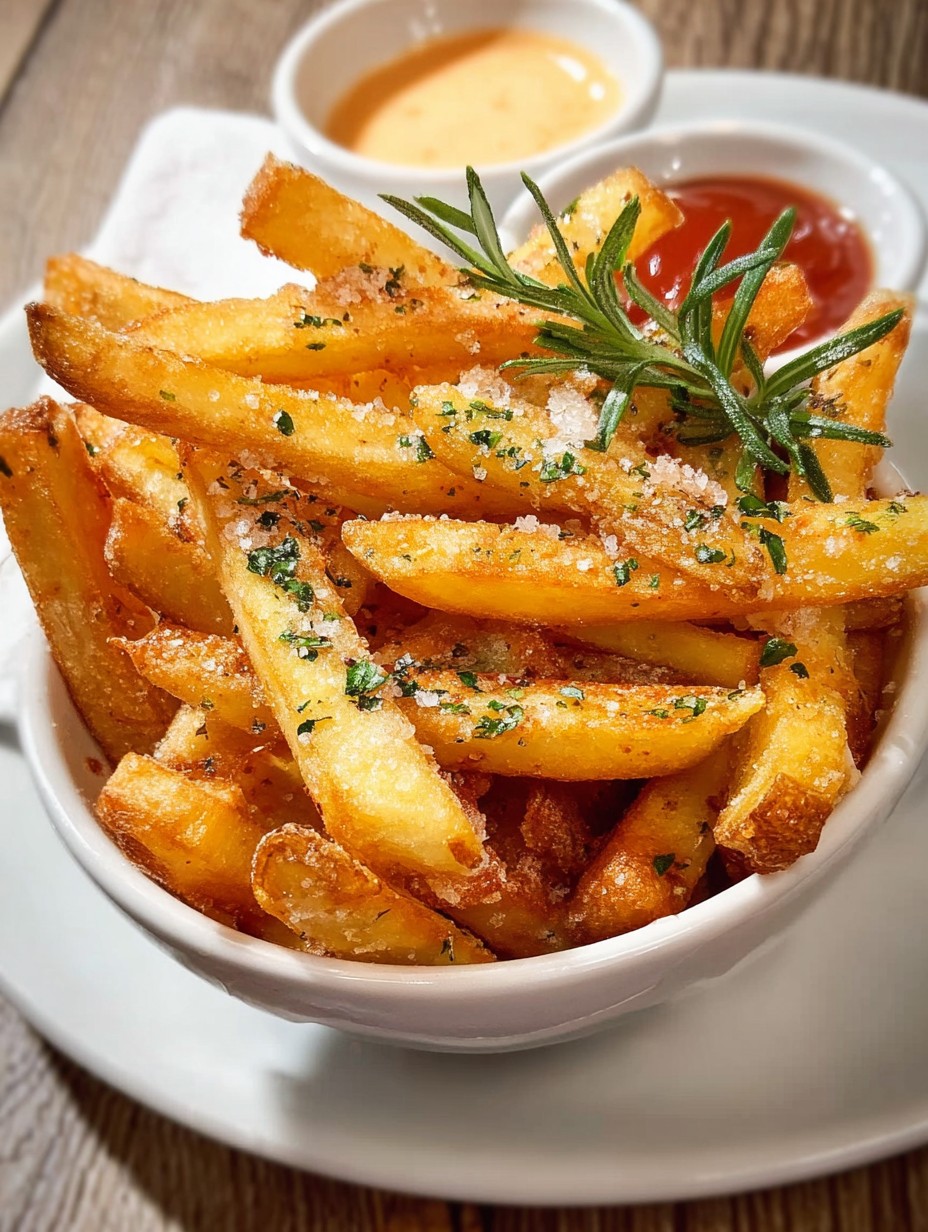Honestly, Fries Are My Love Language (And Here’s Why)
You know that craving you get at 9 PM on a random Tuesday where nothing but fries will do? That’s me basically every week. I remember the first time I tried making homemade fries—let’s just say, if fries could talk, those ones would have shouted for help. These days, though, I’m feeling pretty smug about my technique (except that one time I used sweet potatoes instead. Not my proudest moment). Anyway, this recipe is for anyone who’s ever wanted fries that are golden, crunchy, and oddly comforting. And you don’t need a fancy deep fryer or anything—promise.
Why I Keep Coming Back to This Recipe
I make this when my niece comes over, since she says mine are better than any drive-thru (not sure if that’s a compliment to me or just a burn on fast food). My family goes wild for these fries because they’re, well, extra crispy—like, do-they-even-hear-the-movie crispy. Though sometimes, the whole kitchen smells like a chip shop for two days, but that’s a small price to pay, right? If yours come out soft or a bit sad, don’t give up. I’ve done it all wrong, too. Persistence is the secret ingredient, apparently.
You’ll Need These Ingredients (Plus My Swaps and Secrets)
- Russet potatoes (I swear by Maris Piper, but honestly, anything starchy works. My gran only used King Edward—she’d roll her eyes at my frozen fries phase).
- Neutral oil—like sunflower or canola (I have, in a pinch, used olive oil when I ran out. Gives it more punchy flavor, but sunflower’s my go-to).
- Salt (Maldon, table, or even that pink Himalayan stuff if it matches your kitchen—no judgment).
- (Optional) Paprika, garlic powder, pepper. Or that fancy smoked salt you got once and forgot about.
- (Also optional) A bit of vinegar for pre-soaking, if you’re feeling extra.
How I Actually Make Perfect Homemade Fries
- Peel (or don’t) and cut potatoes: Honestly, sometimes I’m too lazy to peel them. Slice into whatever fry shape you like—about as thick as your pinky, or thinner if you’re counting calories. Wedges, batons, or whatever weird shape you end up with.
- Soak those spuds: Dump them in a bowl of cold water for at least 30 minutes. Helps with crisping later. If you forget and skip this, they’ll still taste great (I’m just saying, maybe a bit more gluey). Sometimes I add a splash of vinegar, but not always.
- Dry thoroughly: This is where I always lose a tea towel or two. Pat ’em super dry; more water means less crisp.
- First fry (the gentle one): Heat oil in a big pot or deep pan to about 325°F (160°C)—or just until a cube of bread sizzles gently and slowly browns. Don’t overcrowd. Fry potatoes in batches for 5–7 minutes. They’ll look pale and sort of sad. That’s normal. Remove with slotted spoon and drain on a wire rack or a pile of paper towels (thick as your winter coat).
- Crank up the heat for the second fry: Now, bring oil to 375°F (190°C). Fry the potatoes again (still in batches) for 2–4 minutes until golden. This bit’s magic. They go from beige to gorgeous real fast. Sometimes I lose track of time chatting and burn a few. That’s just how it goes.
- Season: Grab a salt shaker and go wild while they're hot. The chips will thank you.
A Couple of Honest Notes
- Don’t stress about measurements—some nights I use two potatoes, others six. Just eyeball it;
- Actually, I find it works better if you use last week’s potatoes. Genuinely. New crop are a bit watery.
- Sometimes I skip the soaking and barely notice the difference. But not always.
- My stove is old and the temperature is a lie, so if the fries take longer, you’re probably fine.
All the Variations I’ve Tried (And Some I Regret)
- Cheesy fries—just throw on some grated cheddar at the end. Melts fast, almost too fast.
- Sweet potato fries: I want to love these, but honestly, they’ve never crisped up for me. Maybe I need a better oven.
- Spicy: A sprinkle of cayenne or smoked paprika in the oil can be fun. Once did this with five-spice powder by mistake; still tasty but weirdly Christmassy.
- Baked instead of fried: They’re not quite as crunchy, but less mess. Here’s a solid version I like to use when I’m feeling lazy from Serious Eats.
- Air fryer: If you have one, give it a go—I keep borrowing my neighbor’s but keep forgetting to give it back.
What If You Don’t Have All the Gear?
I don’t own a real deep fryer, either! You can use a big heavy pot (mine’s a battered old Dutch oven) and a slotted spoon. If you don’t have a thermometer, just drop a bit of bread in the oil and see how it sizzles—kind of fun in a science experiment way (though maybe don’t test too many pieces or you’ll be fishing out soggy crumbs)

How Long Do They Keep?
Fries can be stored in the fridge in an airtight container for up to two days, but honestly, in my house, they barely survive the movie. If you must, reheat in the oven at 400°F for about 10 minutes. Cold fries dunked in mayo are a guilty pleasure, too.
For more fry-resurrection tips, check out this reheating guide from BA (though—on second thought—reheating is rarely necessary).
Our Family’s Fry Rituals (And How We Serve Them)
Personally, I love mine with malt vinegar and a wodge of mayo on the side (my dad swears by ketchup, but what can you do?). Occasionally, we dump them on newspaper and eat them at the kitchen table—just for nostalgia. Every so often, I make a big batch and serve them as a weird snack while watching footie. Goes down a treat.
Things I’ve Learned the Hard Way (AKA Pro Tips)
- I once tried skipping the drying step, just to save time. Big mistake—more like mashed potatoes.
- Piling too many fries in at once cools the oil way down; patience here means crispier results.
- I’ve cut fries both super-thin and chunky as doorstops. Somewhere in-between seems to work best, but honestly, there are no fry police.
Fry Trouble? Here’s What I’ve Been Asked Before
- Can I use any kind of potato?
- Yep. Starchy ones work best, but use what you’ve got. I swear the best batch I made was with leftovers. Old spuds have character!
- How do I avoid soggy fries?
- Soak, dry, and double fry. Don’t crowd the pan. But even then, a rainy day seems to mess with things—who knows why!
- Can I reuse the oil?
- Sure, as long as it doesn’t smell weird or look cloudy. I pour it back into its bottle once cooled (label it ‘FRY OIL’ so nobody tries to make salad dressing from it!).
- Will oven fries work if I skip frying?
- Probably. They’ll be lighter but not quite as crispy. Here’s a BBC Good Food version I sometimes follow, though I add way more salt and pepper.
- What about freezing?
- Technically, yes, but homemade fries lose their crunch after freezing. I usually just make what I know will be eaten that day (or maybe the next morning with eggs... don’t judge me).
Ingredients
- 4 large russet potatoes
- 6 cups vegetable oil (for frying)
- 2 teaspoons salt, divided
- 1 teaspoon garlic powder
- 1 teaspoon paprika
- ½ teaspoon black pepper
- Cold water (for soaking)
- Optional: chopped parsley for garnish
Instructions
-
1Peel potatoes (optional), then cut them into ¼-inch thick sticks. Place into a large bowl of cold water and soak for at least 30 minutes to remove excess starch.
-
2Drain the potatoes and pat them completely dry with a clean kitchen towel or paper towels.
-
3Heat vegetable oil in a deep fryer or heavy-bottomed pot to 325°F (165°C). Working in batches, fry potatoes for 3-4 minutes until soft but not browned. Remove and drain on paper towels.
-
4Increase oil temperature to 375°F (190°C). Fry the potatoes again in batches for 2-4 minutes or until golden brown and crispy. Drain again on paper towels.
-
5While hot, season fries immediately with 1 teaspoon salt, garlic powder, paprika, and black pepper. Toss to coat and garnish with chopped parsley, if desired. Serve immediately.
Approximate Information for One Serving
Nutrition Disclaimers
Number of total servings shown is approximate. Actual number of servings will depend on your preferred portion sizes.
Nutritional values shown are general guidelines and reflect information for 1 serving using the ingredients listed, not including any optional ingredients. Actual macros may vary slightly depending on specific brands and types of ingredients used.
To determine the weight of one serving, prepare the recipe as instructed. Weigh the finished recipe, then divide the weight of the finished recipe (not including the weight of the container the food is in) by the desired number of servings. Result will be the weight of one serving.
Did you make this recipe?
Please consider Pinning it!!


